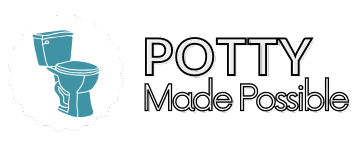Using Rewards vs. Praise
Choosing an approach for potty training can feel like a big challenge. What potty seat should I use? Should I ditch the diaper completely? Will my child respond to this approach? The questions and decisions can feel endless. One of the things that you will have to decide is if you are going to incorporate a reward. In the world of parenting, there are a lot of different opinions and ideas floating around about rewards. In this blog, we’re going to help you decide if a reward is the right choice for your child and, to do so, we’re going to start by explaining an important concept: reinforcement!
Understand the Purpose of a Reward
In order to decide if using a reward during potty training is for you and your child, we want to start by explaining the reasoning behind using one. Before doing so, we want you to know that a reward is a type of reinforcer. So, let’s talk about the term reinforcement, what it means, and how it can apply to potty training.
What is reinforcement?
This is going to get a little science-y but bear with us. Reinforcement refers to adding or removing something after a behavior (pee/poop in the potty) occurs that INCREASES the likelihood that the behavior will occur again in the future. The stimuli that is added or removed can only act as a “reinforcer” if and only if we see the behavior increase in the future.
Current:
Behavior (Pee/Poop in the potty) -> Stimuli Added/Removed (Possibly a reinforcer)
If the stimuli that was added or removed was reinforcing, then the behavior is more likely to occur in the future under similar conditions. Also, if there is a motivation for the reinforcer and the person knows that the reinforcer is available, the person is more likely to engage in that behavior.
Future:
Motivation for stimuli/reinforcer + Reinforcer is Available -> Behavior (pee/poop in the potty) -> Stimuli Added/Removed (Reinforcement)
Reinforcement simplified
Okay, let’s break that down in terms we can easily follow using a potty example!
Your child goes pee in the potty (this is the behavior – peeing in the potty). You give your child a high five and a sticker (possibly reinforcers) and that makes them smile. Later that day, your child is motivated for a high five and sticker (they didn’t get any other high fives or stickers since the last time they went potty) and they see you there and the sticker page in the bathroom (reinforcers are available). Your child goes pee in the potty and you give them high fives and a sticker. This tells us, the first successful pee in the potty was reinforced by the high five and sticker and then they continued to pee in the potty to get the high five and sticker.
Why does reinforcement matter?
The goal of potty training is to teach our child a new skill - peeing and pooping in the potty. Learning a new skill takes practice, helpful teaching strategies, and something that will motivate your child to keep working on mastering their new skill. Using a reinforcer during potty training (one that truly reinforcers your child peeing/pooping in the potty) is going to help motivate your child to get to the goal - Potty Trained!
Rewards versus Praise
Here’s the thing about rewards: Rewards are one type of reinforcement.
Rewards are what we would call a “tangible reinforcer” - something your child can have, hold, eat, watch. Examples of rewards you might use during potty training include a gummy, sticker, new toy, and screen time.
Another type of reinforcement is social reinforcement. “Social reinforcers” are things like praise, high fives, tickles, hugs, etc.
Still unsure about using rewards or praise during potty training?
I’m going to guess if you’re on the fence about using a reward, you’re comfortable with using things like praise to celebrate when your child successfully pees and poops on the potty. If your child’s new potty skills are reinforced by praise - great! That will motivate your child to keep working towards peeing and pooping on the toilet. However, some kids will benefit from an added reward (or “tangible reinforcer”) to really get them motivated to go potty.
Keep in mind: Regardless of the reinforcer you choose to use to help your child learn to go potty, you will always want to make sure you have a plan to fade out that reward. After all, we totally get that you don’t want to be cheering for tinkles or giving stickers for poop forever.
At the end of the day, the decision is absolutely yours to make!
Our goal is to help you feel confident to pick an approach that is the best fit for your child. Understanding the concept of reinforcement will help you decide what type of reinforcer you want to consider using to help your child master potty training!



